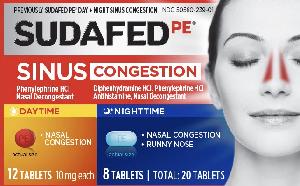Sudafed PE Sinus Congestion Nighttime Interactions
There are 578 drugs known to interact with Sudafed PE Sinus Congestion Nighttime (diphenhydramine / phenylephrine), along with 12 disease interactions, and 2 alcohol/food interactions. Of the total drug interactions, 42 are major, 533 are moderate, and 3 are minor.
- View all 578 medications that may interact with Sudafed PE Sinus Congestion Nighttime
- View Sudafed PE Sinus Congestion Nighttime alcohol/food interactions (2)
- View Sudafed PE Sinus Congestion Nighttime disease interactions (12)
Most frequently checked interactions
View interaction reports for Sudafed PE Sinus Congestion Nighttime (diphenhydramine / phenylephrine) and the medicines listed below.
- Aleve (naproxen)
- amoxicillin / clavulanate
- aspirin
- atorvastatin
- Benadryl (diphenhydramine)
- benzonatate
- cephalexin
- cyclobenzaprine
- diazepam
- docusate
- doxycycline
- Fioricet (acetaminophen / butalbital / caffeine)
- Flonase (fluticasone nasal)
- fluoxetine
- gabapentin
- hydroxyzine
- levothyroxine
- melatonin
- multivitamin
- omeprazole
- pantoprazole
- prednisone
- tizanidine
- topiramate
- Tylenol (acetaminophen)
- Tylenol Extra Strength (acetaminophen)
- valacyclovir
- Vitamin B12 (cyanocobalamin)
- Vitamin C (ascorbic acid)
- Vitamin D3 (cholecalciferol)
Sudafed PE Sinus Congestion Nighttime alcohol/food interactions
There are 2 alcohol/food interactions with Sudafed PE Sinus Congestion Nighttime (diphenhydramine / phenylephrine).
Sudafed PE Sinus Congestion Nighttime disease interactions
There are 12 disease interactions with Sudafed PE Sinus Congestion Nighttime (diphenhydramine / phenylephrine) which include:
- depression
- cardiovascular disease
- anticholinergic effects
- asthma/COPD
- cardiovascular
- renal/liver disease
- glaucoma
- liver disease
- resp depression
- BPH
- diabetes
- glaucoma
More about Sudafed PE Sinus Congestion Nighttime (diphenhydramine / phenylephrine)
- Compare alternatives
- Drug images
- Side effects
- Dosage information
- During pregnancy
- Drug class: upper respiratory combinations
Related treatment guides
Drug Interaction Classification
| Highly clinically significant. Avoid combinations; the risk of the interaction outweighs the benefit. | |
| Moderately clinically significant. Usually avoid combinations; use it only under special circumstances. | |
| Minimally clinically significant. Minimize risk; assess risk and consider an alternative drug, take steps to circumvent the interaction risk and/or institute a monitoring plan. | |
| No interaction information available. |
See also:
Further information
Always consult your healthcare provider to ensure the information displayed on this page applies to your personal circumstances.


